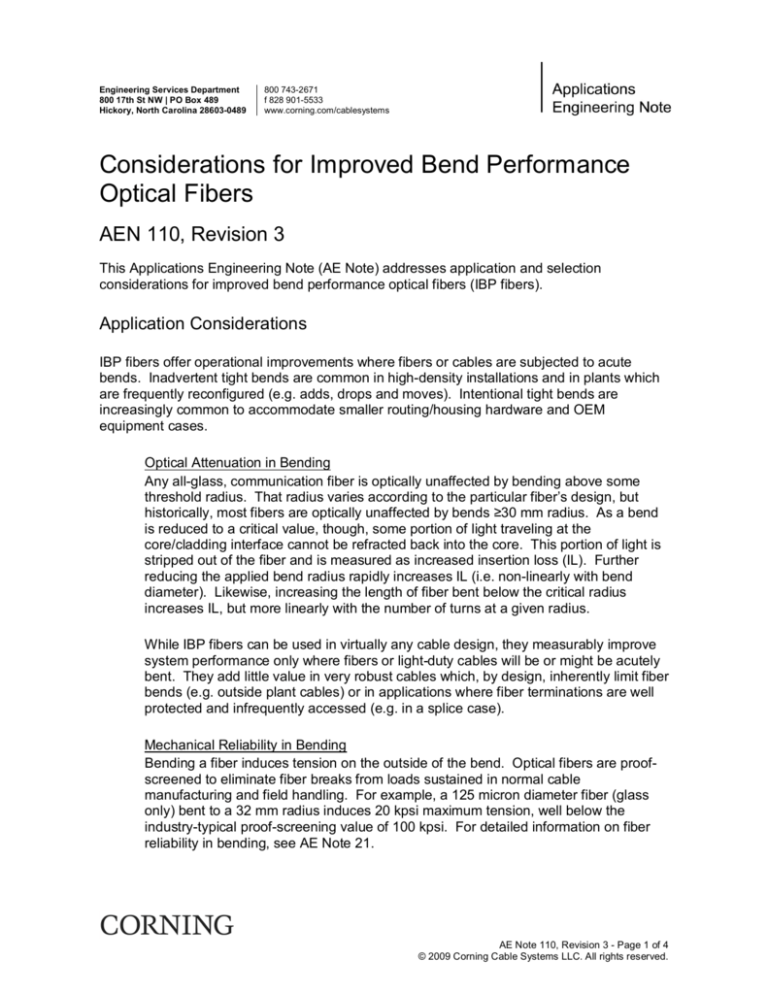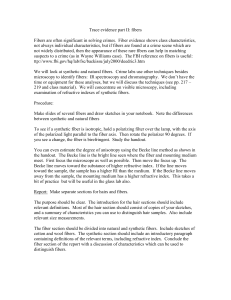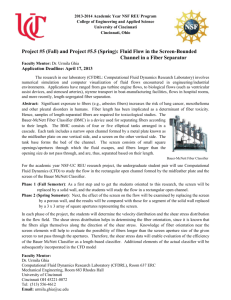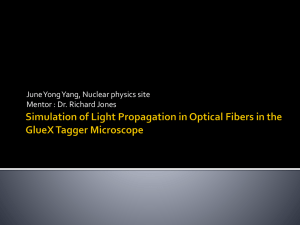
Engineering Services Department
800 17th St NW | PO Box 489
Hickory, North Carolina 28603-0489
800 743-2671
f 828 901-5533
www.corning.com/cablesystems
Considerations for Improved Bend Performance
Optical Fibers
AEN 110, Revision 3
This Applications Engineering Note (AE Note) addresses application and selection
considerations for improved bend performance optical fibers (IBP fibers).
Application Considerations
IBP fibers offer operational improvements where fibers or cables are subjected to acute
bends. Inadvertent tight bends are common in high-density installations and in plants which
are frequently reconfigured (e.g. adds, drops and moves). Intentional tight bends are
increasingly common to accommodate smaller routing/housing hardware and OEM
equipment cases.
Optical Attenuation in Bending
Any all-glass, communication fiber is optically unaffected by bending above some
threshold radius. That radius varies according to the particular fiber’
s design, but
historically, most fibers are optically unaffected by bends 30 mm radius. As a bend
is reduced to a critical value, though, some portion of light traveling at the
core/cladding interface cannot be refracted back into the core. This portion of light is
stripped out of the fiber and is measured as increased insertion loss (IL). Further
reducing the applied bend radius rapidly increases IL (i.e. non-linearly with bend
diameter). Likewise, increasing the length of fiber bent below the critical radius
increases IL, but more linearly with the number of turns at a given radius.
While IBP fibers can be used in virtually any cable design, they measurably improve
system performance only where fibers or light-duty cables will be or might be acutely
bent. They add little value in very robust cables which, by design, inherently limit fiber
bends (e.g. outside plant cables) or in applications where fiber terminations are well
protected and infrequently accessed (e.g. in a splice case).
Mechanical Reliability in Bending
Bending a fiber induces tension on the outside of the bend. Optical fibers are proofscreened to eliminate fiber breaks from loads sustained in normal cable
manufacturing and field handling. For example, a 125 micron diameter fiber (glass
only) bent to a 32 mm radius induces 20 kpsi maximum tension, well below the
industry-typical proof-screening value of 100 kpsi. For detailed information on fiber
reliability in bending, see AE Note 21.
AE Note 110, Revision 3 - Page 1 of 4
© 2009 Corning Cable Systems LLC. All rights reserved.
Selection Considerations - General
While application considerations are similar for either single-mode or multimode fibers,
selection criteria differ somewhat. Considerations common to MM and SM fibers are below,
followed by specific information for each type.
Irrespective of fiber type, Corning jumper cables may be bent to a minimum of 5x the cable
outer diameter or the fiber bend limit, whichever is greater (see Table 1)
Jumper Outer Diameter Minimum Bend Radii (mm)
1.6 mm
8
2.0 mm
10
900 µm (buffered fiber)
5
Table 1
Minimum recommended bend radii for common Corning optical fibers are summarized in
Table 2.
Fiber Type
ClearCurve® SM
G.657.A/B compliant
SMF-28e® XB
SMF-28e®
ClearCurve® MM 50 um
Laser Optimized 50um
62.5um
Table 2
Bend Radius
5mm
7.5mm
10mm
25mm
7.5mm
25mm
25mm
AE Note 110, Revision 3 - Page 2 of 4
© 2009 Corning Cable Systems LLC. All rights reserved.
Selection Considerations for Multimode Fibers
IBP MM fibers were commercialized in 2009 in response to industry needs. Conventional 50
micron fibers are limited to a 25 mm bend radius. IBP MM fibers improve on this limit
considerably. They minimize increased attenuation from tight bends, negating effects of
routing errors and reducing size limitations for fiber optic hardware and OEM equipment.
Corning’
s ClearCurve® 50 micron fibers may be bent to a minimum radius of 7.5 mm.
Wavelength
(nm)(1)
850
1300
Induced Attenuation
(dB)
< 0.1
< 0.3
Mandrel
Radius (mm)
15
15
Number of
Turns
2
2
850
1300
< 0.2
< 0.5
7.5(2)
7.5
2
2
Notes:
Table 3
(1) ClearCurve 50 micron MM fiber is bend optimized at 850 nm,
though bend performance is improved vs. conventional 50 micron
fiber at both operating wavelengths.
(2) Minimum recommended radius for ClearCurve® 50 micron MM fiber
is 7.5 mm
®
AE Note 110, Revision 3 - Page 3 of 4
© 2009 Corning Cable Systems LLC. All rights reserved.
Selection Considerations for Single-mode Fibers
IBP SM fibers have been commercially available for several years. ITU recommendation
G.657 (2006) specifies two classes of IBP single-mode fibers.
G.657 Class A fibers are specified for a minimum bend radius of 10 mm, allowing up to
0.75dB increase in one turn. Further, the mode field range is backward compatible with
G.652 (single-mode) fibers.
G.657 Class B fibers are specified for a minimum bend radius of 7.5 mm, allowing up to
0.5dB increase in one turn. However, the class allows for a minimum mode field of 6.3
microns. Fibers commercially available at the time of G.657 publication were not backward
compatible with G.652 fibers. Since that time, fibers meeting the compatibility requirements
of G.657A and meeting or exceeding the bend requirements of G.657B have been
commercialized. Corning’
s IBP SM fibers are summarized in Table 4.
Fiber Type
Induced Attenuation
@ 1550nm (dB)
< 0.1
< 0.05
Mandrel
Radius (mm)
5(1)
7.5
Number of
Turns
1
1
G.657.A/B
compliant
< 0.4
7.5(2)
1
SMF-28e® XB
SMF-28e® XB
< 0.5
< 0.05
10(3)
16
1
10
SMF-28e®
< 0.05
ClearCurve® SM
ClearCurve® SM
Notes:
16
1
Table 4
(1) Minimum recommended radius for ClearCurve® SM fiber is 5 mm
(2) Minimum recommended radius for G.657.A/B is 7.5 mm
(3) Minimum recommended radius for SMR-28e® XB fiber is 10 mm
AE Note 110, Revision 3 - Page 4 of 4
© 2009 Corning Cable Systems LLC. All rights reserved.








